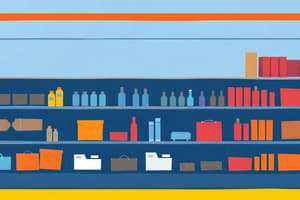Podcast
Questions and Answers
What is retailing?
What is retailing?
- All activities related to the sale of goods and services to the ultimate consumer for personal use (correct)
- Selling goods and services to businesses
- Distributing goods to retail locations
- Marketing goods to wholesalers
Retail establishments can be classified based on type of ownership, level of service, product assortment, and ______.
Retail establishments can be classified based on type of ownership, level of service, product assortment, and ______.
price
Which of the following is NOT a classification of retail operations based on ownership arrangement?
Which of the following is NOT a classification of retail operations based on ownership arrangement?
- Online-only retailer (correct)
- Independent retailer
- Chain store
- Franchise
What does 'gross margin' refer to in retail?
What does 'gross margin' refer to in retail?
Which type of discount store offers limited service and a wide range of nationally branded goods?
Which type of discount store offers limited service and a wide range of nationally branded goods?
What is an example of nonstore retailing?
What is an example of nonstore retailing?
What is a category killer store?
What is a category killer store?
What are hybrid retail operating models?
What are hybrid retail operating models?
Flashcards are hidden until you start studying
Study Notes
Retailing Overview
- Retailing encompasses all activities involved in selling goods and services to ultimate consumers for personal use.
- Retailers act as channel intermediaries primarily focused on consumer sales.
- The American retail industry is predominantly comprised of small businesses, yet it is significantly influenced by a few large corporations.
Classification of Retail Operations
- Retail operations can be categorized by:
- Type of ownership
- Level of service provided
- Product assortment
- Pricing strategy
Ownership Arrangements in Retail
- Independent Retailer: Owned by an individual or a collective of individuals, not part of a larger chain.
- Chain Store: A group of identical stores operated by a single organization.
- Franchise: A business model where the franchisor grants rights to the franchisee to operate and sell specific products or services.
Levels of Service and Product Assortment
- Level of Service: Varies from full-service options to self-service models. Self-service can include product kiosks or vending machines.
- Product Assortment:
- Width: Refers to the variety of different product lines offered.
- Depth: Indicates the number of brands available within each product line.
- Price:
- Gross Margin measures retailer profit as a percentage of sales post the cost of goods sold.
Types of Discount Stores
- Full-line Discount Stores: Offer minimal service and a wide selection of nationally branded goods (e.g., original Wal-Mart).
- Supercenters: Expand full-line offerings to include groceries and various services (e.g., pharmacies, salons) (e.g., current Wal-Mart).
- Specialty Discount Stores: Focus on a narrow category of products, often dominating their niche (e.g., Autozone).
- Warehouse Clubs: Sell bulk goods at discounted prices for members (e.g., Costco).
- Off-price Retailers: Offer products significantly below traditional prices by making cash purchases and not allowing returns (e.g., TJ Maxx, Marshalls). Includes factory outlets and secondhand retailers.
Nonstore Retailing Methods
- Involves purchasing goods without a physical store visit, including:
- Automatic Vending: Machines offering products (e.g., Best Buy locations in airports).
- Technological Self-Service: Interfaces like ATMs enabling user transactions without staff assistance.
- Direct Retailing: Sales by representatives (e.g., Tupperware).
- Direct Marketing: Approaches like TV shopping (e.g., QVC) to encourage purchases outside retail environments.
- Telemarketing: Selling products directly over the phone.
- Direct Mail: Sending promotional materials via postal or electronic channels.
- Online Retailing (E-tailing): Shopping through internet platforms (e.g., Amazon), often using data analytics for targeted marketing.
Evolving Retail Operations Models
- The limitations of traditional retail models have inspired hybrid approaches and exclusive online retailers.
- Online-only retailers generally enjoy lower operating costs and a global customer reach (e.g., Vistaprint).
- Many physical retail operations maintain traditional and tactical methods similar to conventional business practices.
Studying That Suits You
Use AI to generate personalized quizzes and flashcards to suit your learning preferences.




